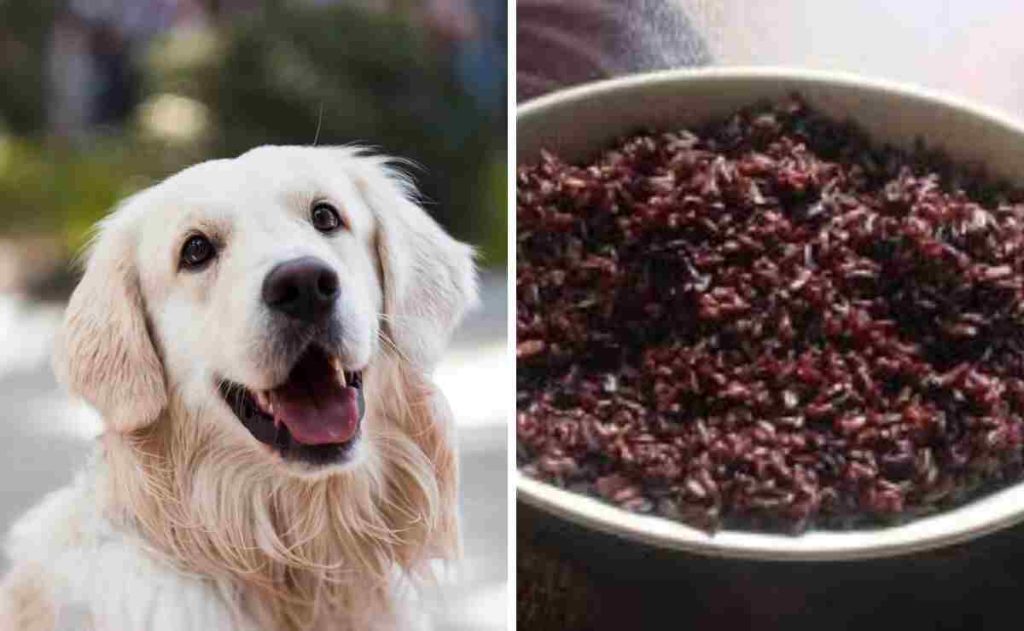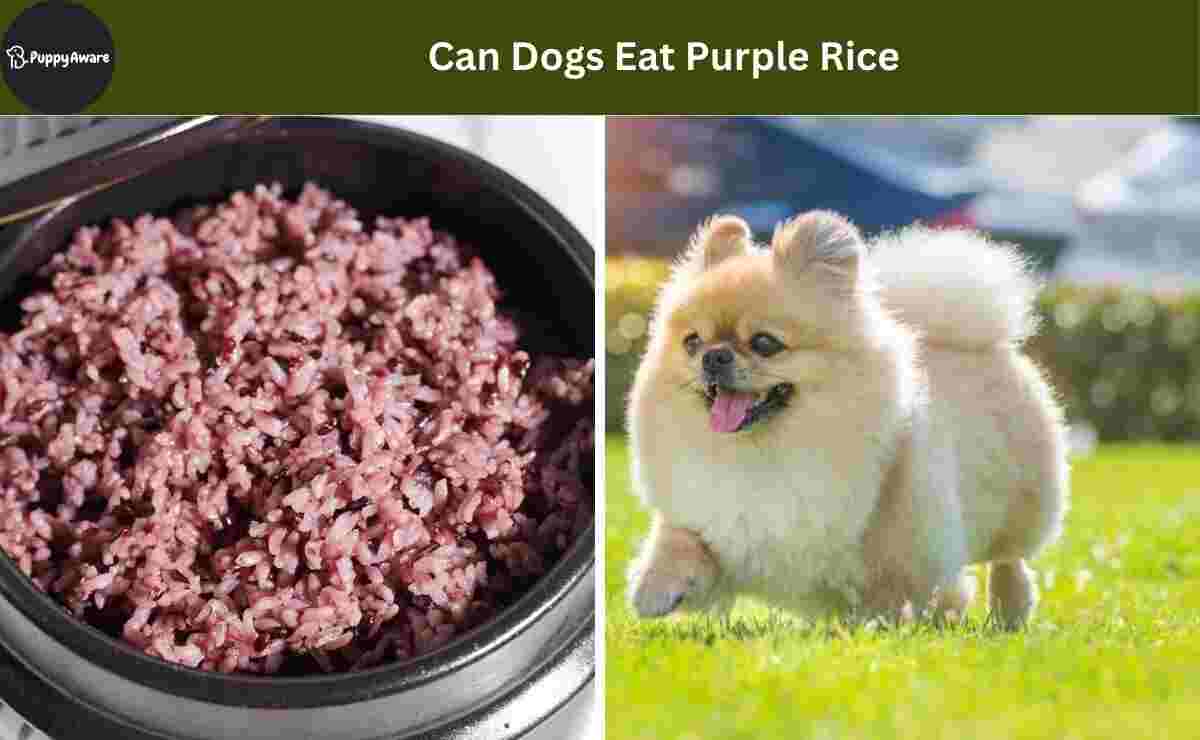Purple rice or black rice is popular as a super nutritious food. But it’s a common question among pet owners – can dogs eat purple rice?
Yes, dogs can eat rice. Many pet owners avoid rice as they are unsure about their safety. But it is totally safe for them to eat.
Dogs can safely consume many types of grains and rice, so they can also eat purple rice without any problem.
Can Dogs Eat Purple Rice?

Purple rice is a type of rice that is rich in antioxidants and nutrients. It has a distinctive color and texture that sets it apart from other varieties of rice. However, before adding it to your dog’s meal plan, consult with your veterinarian to ensure it aligns with their specific dietary requirements.
Rice is safe for dogs, but you should maintain the quantity of feeding. Too much rice can lead to weight gain and digestive issues in dogs. Also, some dogs may have allergies or sensitivities to certain grains, including rice. You should introduce new foods gradually and monitor your dog’s reaction to them.
Is Purple Rice Safe For Dogs To Eat?
Purple rice has gained popularity for its exceptional health benefits. This rice is also safe for your puppy. Not only can it offer them similar nutrients and health perks as it does for us, but it also contributes to a balanced and healthy diet for them.
However, there are potential risks and side effects that pet owners should be mindful of before introducing purple rice into their dogs’ meals.
One risk is the chance of an allergic reaction, especially for dogs sensitive to certain grains like rice. If your dog hasn’t tried purple rice before, introduce it slowly and keep a close eye on any signs of allergies.
Another possible side effect of feeding too much purple rice to your dog is digestive upset. Just like with any new food, a gradual introduction in small amounts is crucial to avoid upsetting your dog’s stomach.
As a general rule, the amount should not exceed 10% of their daily caloric intake from treats or human food. For instance, if your dog needs 500 calories a day, limit purple rice treats to no more than 50 calories.
Is Purple Rice More Healthier Than White Rice?
Purple rice has gained popularity as a healthier alternative to white rice for dogs. While both types of rice are a source of carbohydrates and can provide energy for dogs, purple rice is often touted for its higher nutritional content and health benefits.
Purple rice gets its distinct color from the presence of anthocyanins, which are powerful antioxidants known for their anti-inflammatory properties. These antioxidants have been linked to various health benefits.
In addition to being rich in antioxidants, the rice also contains higher levels of vitamins, minerals, and fiber compared to white rice. These nutrients can support a dog’s immune system, aid in digestion, and contribute to overall health and vitality.
While purple rice may offer some advantages, it should not completely replace other essential components of a balanced canine diet.
Furthermore, it’s worth mentioning that individual dogs may have different dietary needs and sensitivities. Some dogs may not tolerate rice well and require a different diet. So you should provide the most appropriate and beneficial diet for your specific dog.
How Much Rice Can You Feed Your Dog?
Feeding your dog a balanced and nutritious diet is important. Rice is a beneficial addition to your dog’s diet as it is a good source of carbohydrates and is also easily digestible with sensitive stomachs.
Well, the right amount of rice to feed your dog depends on their size, age, and activity level. As a general guideline, you can start by feeding your dog 1/4 to 1/2 cup of cooked rice per meal, depending on their weight.
However, this is just a starting point, and you should monitor your dog’s weight and adjust their portion size accordingly. Rice should not be the main component of your dog’s diet. It should be served as a part of a well-balanced meal that includes protein, vegetables, and other essential nutrients.
How to Prepare Purple Rice for Dogs?
To prepare purple rice for dogs, there are a few important steps to follow:
- Start by rinsing the rice in cold water to remove any dirt or debris.
- Then, add the rice to a pot with the appropriate amount of water.
- To cook the rice, add enough water to the rice. The ratio of water to rice may vary depending on the specific type of purple rice, so be sure to read the package instructions.
- Next, bring the water and rice to a boil. Once it starts boiling, reduce the heat to low and cover the pot with a lid.
- Allow the rice to simmer for the recommended cooking time, typically around 20-30 minutes.
- During this time, make sure to check on the rice occasionally to prevent it from sticking to the bottom of the pot.
- Once the rice is fully cooked, remove it from the heat and let it cool down before serving it to your dog.
- Avoid using any seasonings or additives that may be harmful to them. Plain, cooked purple rice is the most suitable option for your dog.
Benefits of Purple Rice for Dogs

1. Improved Digestion: Purple rice contains a high amount of dietary fiber, which is helpful in healthy digestion in dogs. It can help regulate bowel movements, prevent constipation, and reduce the risk of gastrointestinal issues.
2. Enhanced Immune System: This rice is rich in antioxidants, such as anthocyanins, which can help strengthen the immune system of dogs. These antioxidants work to fight against free radicals and reduce inflammation, ultimately promoting a healthier immune system.
3. Promotes Joint Health: The natural compounds in rice like anti-inflammatory properties can be beneficial for dogs, especially older dogs or those with arthritis. It helps in reducing joint pain and swelling.
4. Improved Heart Health: Purple rice has been shown to have positive effects on heart health in dogs. It contains a low amount of fat and cholesterol while being rich in essential nutrients like vitamins, minerals, and omega-3 fatty acids. These nutrients can support a healthy cardiovascular system in dogs.
5. Healthy Weight Management: Purple rice is a complex carbohydrate that provides dogs with a sustainable source of energy without causing spikes in blood sugar levels. This can aid in weight management by keeping dogs feeling fuller for longer periods and preventing excessive snacking or overeating.
6. Increased Energy Levels: The carbohydrates found in purple rice can provide dogs with a steady release of energy throughout the day. This can be especially beneficial for active or working dogs that require sustained energy levels for optimal performance.
7. Enhanced Skin and Coat Health: Purple rice is a good source of essential vitamins and minerals that support healthy skin and a shiny coat in dogs. The nutrients found in purple rice can help prevent skin issues, reduce dryness, and improve overall coat appearance and texture.
Conclusion
Dogs can eat purple rice without any issues. It offers certain nutritional benefits and health advantages over white rice. So you can make it as part of a balanced and varied diet for dogs.
Anyway, you can consult with a veterinarian before introducing any new food into your dog’s diet. They can suggest whether purple rice is suitable for your dog’s specific needs and health conditions.
Related Posts
